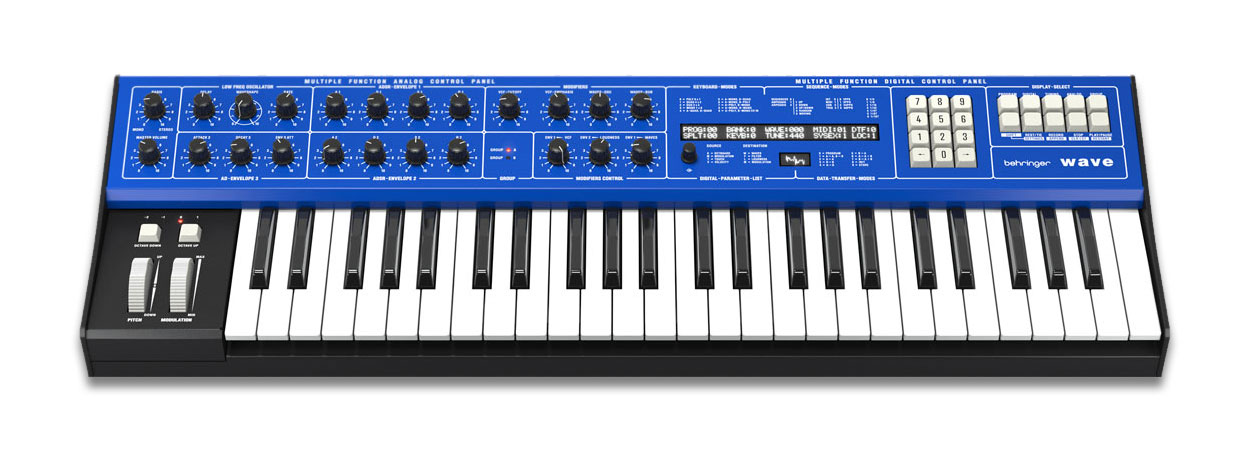BEHRINGER WAVE - A Modern Interpretation of the Legendary PPG Wave

Behringer Wave is a hybrid wavetable synthesizer that combines digital wavetable generators with an analog filter and amplifier. This instrument is inspired by iconic synthesizers from the 1980s, particularly the PPG Wave, designed by Wolfgang Palm. With modern features and expanded editing capabilities, Behringer Wave offers unique sound possibilities that extend classic wavetable synthesis.
History and Development of Behringer Wave
Behringer Wave was designed as a modern interpretation of the PPG Wave, one of the most influential synthesizers of the 1980s. Wolfgang Palm, founder of Palm Products GmbH (PPG), developed the PPG Wave 2.2 and 2.3, which became pioneers of wavetable synthesis.
The PPG Wave was one of the first synthesizers to combine digital oscillators with an analog filter, enabling a complex sonic spectrum. This concept became the foundation for many modern synthesizers, including Behringer Wave, which delivers an improved version of this technology.
How Behringer Wave Works
Behringer Wave operates on wavetable synthesis, meaning the sound is generated using digital wavetable forms that contain various wave shapes. These waveforms can be smoothly interpolated, allowing for complex modulation and dynamic sound changes.
Key Elements of the Synthesis
• Two wavetable generators per voice – Each voice has two independent oscillators that can
operate in 8-bit or 16-bit mode.
• Memory for user wavetables – Capability to store 64 custom wavetables, 32 transition effects, and
200 presets.
• Analog low-pass filter with resonance – Provides warm analog coloration similar to the PPG Wave.
• Two ADSR envelopes and one AD LFO – Enables precise sound shaping.
• Dual arpeggiator and polyphonic sequencer – Expanded options for automation and sequencing.
Structure and Control of Behringer Wave
Behringer Wave features 49 full-sized keys that are velocity-sensitive and support aftertouch. The control interface is designed for quick access to essential parameters.
Main Control Elements
• 22 rotary knobs – Direct control of key synthesis parameters.
• LCD display with data encoder – Clear sound programming.
• OLED waveform display – Visualization of the current wave shape.
• Pitch and modulation wheel – Expressive control over pitch and modulation.
• Octave switch – Quick adjustment of keyboard range.
Editing and Sound Design Capabilities
Behringer Wave offers extensive editing options, allowing for the creation of unique sounds.
Editing Functions
• Manual control of wavetable interpolation – Ability to adjust transitions between waveforms
manually.
• Stereo sound width – Option to expand stereo imaging.
• Individual outputs for each voice – Enables separate processing of individual voices.
• CV/Gate and MIDI connectivity – Integration with modular systems and DAWs.
Rear Panel of Behringer Wave – Inputs and Outputs
Behringer Wave is equipped with a wide range of inputs and outputs, ensuring flexible connection to studio equipment.
Audio Outputs
• 2 main outputs (L/R, 6.3 mm jack) – Stereo mixed output.
• 8 individual voice outputs (6.3 mm jack) – Separate output for each voice.
• Stereo headphone output (6.3 mm jack) – Direct monitoring.
Digital and Analog Inputs
• Expression and sustain pedal inputs (6.3 mm jack) – Expressive control options.
• CV/Gate inputs (6.3 mm jack) – Connection to modular systems.
• Sync input/output (6.3 mm jack) – Synchronization with external sequencers.
MIDI and USB Connectivity
• MIDI In/Out (5-pin DIN) – Full MIDI integration.
• USB-B port – Connection to a computer.
Advantages and Disadvantages of Behringer Wave
Advantages
• Behringer Wave is based on the legendary PPG Wave and brings the classic wavetable sound
made famous by Wolfgang Palm. Thanks to its hybrid combination of digital oscillators with
an analog filter, it merges digital precision with the warmth of analog circuitry, enabling flexible
sound creation.
• Another advantage is its extensive memory, which provides the ability to create custom wavetables
and interpolate between different forms, resulting in deep and evolving sonic textures. Behringer
Wave offers manual waveform control, expanded stereo width, and individual outputs for each
voice, allowing for detailed studio processing.
• From a connectivity standpoint, it provides excellent integration, including CV/Gate, MIDI,
USB, and individual audio outputs, making it ideal for studio use. Additionally, its built-in arpeggiator
and polyphonic sequencer make it an excellent instrument for both live performance and
complex sequencing.
Disadvantages
• A factor that may affect workflow is the need for in-depth editing of user wavetables. Creating
complex sounds requires significant programming time, which may be less intuitive for
musicians seeking quick results without manually adjusting interpolations and parameters.
• Therefore, a practical option is to purchase third-party sound program collections containing
pre-configured wavetables and complex sounds, significantly speeding up music creation and
allowing a focus on the creative process rather than synthesis details.
• Pitch interpolation between waveforms is not always perfectly smooth, meaning that rapid
switching may produce audible sound changes. Finally, the limited number of effects should
be noted. Although the synthesizer features a solid internal processor, advanced effects need
to be handled externally, requiring additional investment in studio equipment.
Conclusion
Behringer Wave is a modern hybrid wavetable synthesizer inspired by the structure of the PPG Wave, designed by Wolfgang Palm. With digital wavetable generators, an analog filter, extensive editing capabilities, and flexible connectivity, it is an ideal choice for musicians, producers, and sound designers.
| |
|
|
|
|
|
|
|
|


